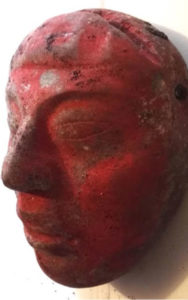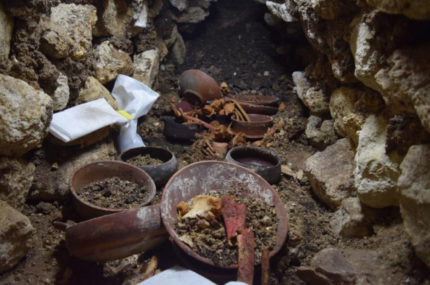Archaeologists excavating the ancient Maya city of El Perú-Waka’ have discovered the oldest known royal tomb of the Wak or Centipede dynasty. The international team from the El Perú-Waka’ Archaeological Project (PAW) found the tomb excavating tunnels under the Palace Acropolis. Analysis of the ceramic grave goods date the tomb to 300-350 A.D. Going from the date alone, the deceased could be King Te’ Chan Ahk who ruled in the early 4th century.
 The skeletal remains of an adult male were found inside the tomb, but there were no inscriptions that would conclusively prove his identity. One artifact did make it clear that this was a royal tomb: a jade funerary mask. The portrait mask, painted a bright red with cinnabar, has a tell-tale hair tab on the forehead characteristic of the Maize God. There’s a symbol on the tab reminscent of a Greek Cross which is a combination of the glyphs for “Yellow” and “Precious,” another reference to the corn deity.
The skeletal remains of an adult male were found inside the tomb, but there were no inscriptions that would conclusively prove his identity. One artifact did make it clear that this was a royal tomb: a jade funerary mask. The portrait mask, painted a bright red with cinnabar, has a tell-tale hair tab on the forehead characteristic of the Maize God. There’s a symbol on the tab reminscent of a Greek Cross which is a combination of the glyphs for “Yellow” and “Precious,” another reference to the corn deity.
[Guatemalan archaeologists Griselda Pérez Robles and Damaris Menéndez] discovered the mask under the head of the ruler, and it may have been made to cover the face rather than as a chest pectoral. Archaeologists at Tikal in the 1960s discovered a similar greenstone mask in the earliest Maya royal tomb, dating to the first century A.D.
Additional offerings in Burial 80 included 22 ceramic vessels, Spondylus shells, jade ornaments and a shell pendant carved as a crocodile. The remains of the ruler and some ornaments like the portrait mask were painted bright red. Burial 80 was reverentially reentered after 600 A.D. at least once, and it is possible that the bones were painted during this reentry.
 El Perú-Waka’ was an important city-state that controlled major north-south and east-west trade routes during the Mayan classical period. It produced a wide range of goods for trade — maize avocados, latex, jade — and its support was hungrily sought after by the greatest rivals of the time: Tikal and Calakmul. The north-south trade route linked the great Classical period Mayan power center of Calakmul in modern-day Campeche, Mexico, with its allies to the south in what is today Guatemala. The rulers of Calakmul, the mighty Snake dynasty, cemented their relationships with the rulers of conquered, vassal and allied cities in strategically significant areas by marriage. Lady K’abel, aka Lady Snake Lord, daughter of King Yuhknoom Ch’een the Great of Calakmul, married King K’inich Bahlam II of the Centipede dynasty in the 7th century.
El Perú-Waka’ was an important city-state that controlled major north-south and east-west trade routes during the Mayan classical period. It produced a wide range of goods for trade — maize avocados, latex, jade — and its support was hungrily sought after by the greatest rivals of the time: Tikal and Calakmul. The north-south trade route linked the great Classical period Mayan power center of Calakmul in modern-day Campeche, Mexico, with its allies to the south in what is today Guatemala. The rulers of Calakmul, the mighty Snake dynasty, cemented their relationships with the rulers of conquered, vassal and allied cities in strategically significant areas by marriage. Lady K’abel, aka Lady Snake Lord, daughter of King Yuhknoom Ch’een the Great of Calakmul, married King K’inich Bahlam II of the Centipede dynasty in the 7th century.
The Wak dynasty long predates the rise of Calakmul and its military and political machinations, however. Drawing from later inscriptions found at El Perú-Waka’, historians believe the dynasty was founded in the 2nd century A.D. making it one of the earliest Mayan ruling families. By the early 5th century A.D., the city’s population numbered in the tens of thousands and the city had dozens of public buildings, squares, religious centers and more. That was the heyday of the city’s prosperity, even though its alliance with Calakmul and the benefits it incurred from the relationship were still hundreds of years away.
“The Classic Maya revered their divine rulers and treated them as living souls after death,” said research co-director David Freidel, professor of anthropology in Arts & Sciences at Washington University in St. Louis.
“This king’s tomb helped to make the royal palace acropolis holy ground, a place of majesty, early in the history of the Wak — centipede — dynasty. It’s like the ancient Saxon kings England buried in Old Minister, the original church underneath Winchester Cathedral.”
